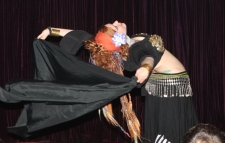on Mon, 05 Dec, 2016

The most important thing about selecting a veil is to try out different veils to see what you like. If you take class with other dancers, you can ask friends will let you try their veils. Sometimes in a class setting you can switch veils to feel the weight and flow of others. I was lucky I had a teacher that allowed students to select from her box of veils to try them out in class. Severina insisted you had to switch them around. I found what worked for me that way. Below are some things I have learned about dancing with a veil.
My favorite fabric to dance with is silk. I have danced with rayon and other thin fabrics but they don’t catch the air the same way. If you are going to the fabric store and making your own veil, thin and light fabric is important.
I love the aesthetics of embroidered veils. I have a white veil with silver sequins that I used in my Frozen themed belly dance performance. But these veils aren’t for dancing. They are better for covering a costume. A veil for dancing needs to be light so it will flow like wind. If you are making your own veil, you will probably need to hem the fabric so it won’t fray, but the more fabric you gather in one place, the heavier it becomes. A rolled hem is probably ideal. My silk veil has a teeny, tiny hem.
If you are only five foot like I am, you don’t need as large of a veil as someone who is six foot, however, my veils are standard sized so I do end up using veils that are a little bigger than what I need. On the other hand, if you are very tall, you might feel a standard size veil isn’t long enough. When I first was learning veil work I was told that your veil needs to be your arm span plus some more. It’s going to be pretty rare you need that much more veil because a dancer holds the fabric at angle that is more like a v than the cross bar of a T. (For ways to hold a veil, see the upcoming blogpost “Five Tips You Need to Know for Holding a Veil.”
The two standard shapes are a rectangle or a half circle. It is far easier to buy a rectangle of fabric from the fabric store and less fraying if you aren’t going to hem it because two sides aren’t cut. My teacher, Severina, in Portland used to use a half-circle and I remember using it several times in class and really liking it. It made a pretty shape when you held it behind you and it was lighter because there was less fabric in two corners. If someone asked me what veil I wanted for my birthday, I would tell them a silk half circle. It would be the next detail that would be difficult for me.
I am always trying to get the most for my money’s worth. If I can use a veil that will match three costumes instead of one, I am pretty happy. On the other hand, sometimes I need a certain prop for a certain performance and I instead have to ask myself if the color of the veil matches the costume I intend to dance in. My favorite veil used to be my tie-dyed rainbow veil a friend hand dyed for me in Portland, Oregon while I was dancing as a student performer at Gypsy Caravan Studio. That veil matched everything including my rainbow hair extensions. Then I moved to Eugene. There was so much tie-dye everywhere. I did not want my identify to be a rainbow hippie belly dancer. Now I have several other veils and I use other props as well.
For “Five Tips You Need to Know for Holding a Veil,” see the next post.
If you are interested in learning tribal veil work, go to my contact form and send me an email for a private lesson.